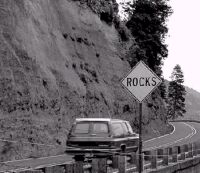|
Safe or Scenic?
Columbia Gorge Commission Pressured WSDOT
to Compromise Safety for Scenic Views
By Becky Blanton - Editor of the Klickitat
County Monitor
|
Klickitat County, WA - 4/15/02 -
The issue of safety and the priority of “natural scenic
vistas” versus netting, mesh and other safety measures was
raised again at a recent Columbia River Gorge meeting in Cascade
Locks, WA, but was met with an unsettling answer.
HARD ROCKS, HARD CHOICES

Efforts to make fallen rock zone safer for motorist
compromise by 'green' mindset. Photo by Becky
Blanton
|
Klickitat County Gorge Commissioner Kenn Adcock
asked Washington State Department of Transportation (WSDOT)
engineer Chuck Ruhsenberger if WSDOT had ever been or felt
pressured to compromise highway safety to achieve a more
“natural” look to Washington roads in the scenic area.
Before Ruhsenberger could answer, Gorge Commission Chairman Ann
Squire interrupted. “You don’t have to answer that
question,” she said.
Ruhsenberger said, “That’s ok. I’ll answer it. Yes,
we’ve had that conversation, but WSDOT will not compromise
safety.”
While WSDOT acknowledges that they have been pressured to
conform more with scenic concerns than safety concerns, he
assured the commissioners that WSDOT puts safety ahead of scenic
vistas.
WSDOT spokesmen say safety is the core of WSDOT’s concern
about highway 14 throughout Washington and Oregon. There are
dangerously unstable slopes on both highway 14 in Washington and
along I-84 in Oregon.
More than 70 sites along highway 14 in the scenic area have been
identified as being areas at risk to motorists, pedestrians and
recreational users from falling rock.
Ruhsenberger, an area engineer for WSDOT's Columbia Gorge Area
Engineering Office, told Commissioners that an Interdisciplinary
Team (ID Team) made up of representatives from WSDOT, the U.S.
Forest Service, and the Gorge Commission have achieved consensus
on 30 rockfall sites along SR-14.
Twenty-six of the 30 sites are located in Skamania County and
four are located in Klickitat County.
Most of the sites are in Skamania County because of the type of
terrain involved, he said. “These rockfall sites tend to be
clustered in certain areas because of geography and their
proximity to the highway and the railroad.
“However, the four sites in Klickitat County are very
difficult ones, and are priorities for mitigation,” he told
the commissioners.
Ruhsenberger said WSDOT will be seeking public comment on the
rockfall projects as part of the environmental review. After the
environmental assessment is completed by John Meerscheidt of
Herrera Consultants, WSDOT will start project development.
Ruhsenberger and Steve Vestal, a WSDOT design engineer of WSDOT
gave the Gorge Commission an update on the status of the
“unstable slopes project” for Highway 14 from Camas to
Roosevelt, Washington on Tuesday, April 9. Completion of an
environmental review is the next step in a multi-agency project
to reduce rockfall along Washington Scenic Route 14 in the
National Scenic Area.
Depending on WSDOT budget considerations, several of the
rockfall projects could be completed in the next two years, with
the remainder being finished over the next 20 years,
Ruhsenberger said. He stressed that the sites identified in the
project present different challenges and solutions depending on
their terrain and outlined for commissioners various methods and
applications the state agency will use in mitigating rockfall
along the highway.
Possible methods include re-sloping existing slopes,
constructing rockfall ditches, using scale, bolts and shotcrete,
realigning the highway itself, and using wire mesh or another
type of netting called “Euromesh.”
Vestal noted that the ID Team's recommendation does include
specific project recommendations for each of the 30 sites. He
indicated that several of the different design options described
in the presentation would be used. Some of the options have high
construction costs but low maintenance costs. The opposite is
also true of many of the options. No indications were given on
the handouts or during the presentation about which options are
the “safest.” When asked which options were safest,
Ruhsenberger said all methods can be made “equally safe” but
did not give any information about success or failure rates for
any particular method.
Vestal and Ruhsenberger both pointed out that all of the
projects will increase public safety. “Public safety will
never be compromised,” Ruhsenberger said.
A complete description of the 30 proposed rockfall projects is
available from Washington State Department of Transportation,
11018 NE 51st Circle, Vancouver, WA 98668-1709.
Allegations made by motorists, highway workers and local
residents of Lyle, point out the concern with the Gorge
Commission’s history and reputation of preferring to rule on
the side of “looking pretty,” rather than what is
reasonable, economical or based on “plain old common sense.”
The Gorge Commission denies they have ever put “natural or
scenic aesthetics above public safety.”
However, Commissioner Joe Palenae recalled one incident in
Oregon where the Gorge Commission requested that the Oregon
Department of Transportation (ODOT) remove a sign with a
flashing light to warn motorists of hazards ahead. “They said
it wasn’t consistent with the scenic area management plan,”
he said.
|
|